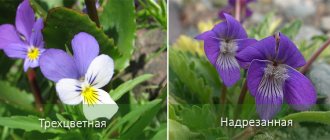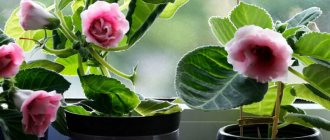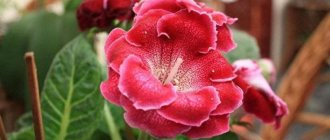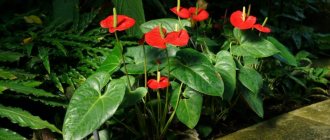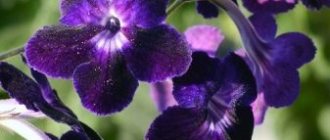Fragrant violets are valued for their wonderful aroma, and also for a fairly simple and at the same time lovely appearance. The Royal Violet variety is very common due to its particularly strong aroma and delicate color.
The plant and grows very easily But it is important to take into account the preferences of the bush to obtain the most beautiful and fragrant flowers. Next you will see a description and photo of the Tsarskaya fragrant violet variety.
Fragrant violet
Fragrant violet has several varieties with a bright aroma ; you can see pictures of some of them below:
- Bechtles Ideal – large-flowered variety, lilac color;
- Coeur d'Alsace – pink color;
- Christmas – white;
- Czar and Tsarskaya – lilac, one of the most fragrant;
- Konigin Charlotte – large dark purple;
- Red Charme – red-purple color;
- Triumph - purple and largest flowers.
All varieties have similar parameters - they are perennial herbaceous flowers, rounded leaves with a heart-shaped base. The flowers are solitary, located on tall thin peduncles; the size and color of the flowers varies depending on the variety.
Distribution area
In nature, the violet grows in Europe, mainly in the west and center .
It usually grows in deciduous forests, preferring edges, clearings and clearings, and is also found on forested mountain slopes.
It usually grows on fertile soils , such as deciduous soil in forests and black soil on roadsides and forest edges.
It is not demanding in terms of lighting, can tolerate direct sunlight, and also grow in shade and partial shade.
Variety "Tsarskaya"
The fragrant violet belongs to the genus of violets (viola), family Violet , order Malpighiaceae, class dicotyledonous. Tsarskaya is one of the varieties of fragrant violas, which is quite widespread due to its simplicity and unsurpassed aroma.
Fragrant Royal Violet is a perennial whose stems retain their green color even in winter. The stems are thick, creeping rhizomes that bear leaves and flower stalks in the spring.
The leaves are heart-shaped at the petiole and pointed at the ends; the edge is usually rounded, but can sometimes be slightly jagged. The color of the leaves changes during growth - young ones are lighter, and the older ones are darker, and can also change depending on the lighting.
Violet Fragrant Royal.
Peduncles appear from the axils of the leaves, they are long and one bud is formed on each.
The flowers have a double perianth, clearly divided into a corolla and a calyx, each petal being free.
The petals are dark purple, there are five of them on each flower , the lowest one is slightly larger than the others and has a spur, usually three petals are directed downwards, two more upwards.
Important! The fragrant royal violet is the most fragrant variety among violas. Flowers of this variety can predict the weather - before the rain they lower their heads and close their petals.
Tricolor violet: description and photo
This herbaceous plant can be:
- Annual;
- Two years old;
- And even for many years. But quite rarely.
What garden plant does the tricolor violet resemble?
Tricolor violet is similar to the grass Molnik, whose smell repels moths.
Grass Molnik.
Mullein cockroaches - Verbascum blattaria L.
The burrow family is Scrophulariaceae.
Common names: moth grass, steppe St. John's wort, Molnik knaflichka.
Name in Latin
Tricolor violet (Viola tricolor - translation into Latin). This is its international scientific name. Since the distant year 1753.
There are many colors of Violet Pansy.
And among flower growers, something else is more common - Pansies. Even flower growers are not very interested in a complete scientific classification. It's all complicated. All sorts of domains, kingdoms and orders. Botanists deal with this more:
- It is a species from the violet family;
- Their genus is Violet.
Folk names
The violet is not so noticeable. Due to its small size. And that’s not the only name they call it. It is distributed in many places where it has its own names:
- Ivan da Marya. Marjannik oak grove is called the same in many places;
- Brother and sister;
- Moths;
- Field brothers;
- Forest brothers;
- Kamchug;
- Half-flower;
- Hatchets;
- Three-flowered;
- Trinity grass.
Wittrock's violet is also called Pansy. And for good reason. This hybrid is bred from tricolor violet. The plant turned out larger and the flowers were brighter. Many flower growers do not always deal with them themselves.
This viola is by no means the only variety. There are many varieties. Amateur flower growers did their best. They grew many hybrids. With bright colors and sizes.
Experts divide it into the following subtypes:
- Curtis (Viola curisii);
- Macedonian (Viola macedonica);
- Morning (Matutina);
- Subalpine (Vila saxatilis);
- And the tricolor itself (Viola tricolor).
Plants are different. Viola arvensis is the name of the Field Violet.
Field violet.
But they also have a lot in common:
- The field violet has white or purple upper petals. Medium - with a bright yellow color (golden);
- Smaller size of the plant and flowers;
- Their composition is almost the same (slightly more alkaloids, but less saponins in the field one);
- And they use it for the same purposes;
- The field violet is distributed over a large area.
Growing from seeds
small seeds are formed in small boxes (length approximately 1.5 mm, thickness - 1 mm). In nature, they are carried by ants and this is how the plant spreads.
If we talk about growing from seeds, when to plant depends on how you are going to do it - seedlings or non-seedlings.
Seedling method
To plant seeds for seedlings, they must be prepared , because good similarity is maintained only for the first two weeks.
Preparations begin in February and the process consists of:
- Seeds are sown in prepared soil. The substrate is made up of peat/leaf soil/perlite/vermiculite/sphagnum moss/charcoal in a ratio of 2/1/1/1/0.5, or purchase a ready-made mixture for Saintpaulias (Usambara violets);
- The seeds are sown on the ground, without sprinkling, and sprayed with a spray bottle, then covered with film ;
- The temperature at this stage is 18-20°C . Periodically, the film is lifted for ventilation and spraying , as necessary. This care is maintained for 2-3 weeks ;
- The next stage is stratification . To do this, the containers are moved to a cold room or refrigerator with a temperature of -4 to 4°C . Then wait 4-6 weeks or until the first shoots appear (whichever is faster);
- Afterwards, the temperature is raised to 5-12°C , and watering must be resumed, but only to maintain low humidity;
- After the appearance of the first full leaf, if necessary, the plants are planted in separate flowerpots ;
- Further care involves a temperature of about 20°C and moderate watering ;
- The seedlings are transferred to the ground in August and must be covered for the winter.
Sowing seeds for seedlings is a rather labor-intensive process, and if you have your own seeds, it is easier and more efficient to sow them for the winter.
Without seedlings
Fresh seeds are sown within two weeks after collection in small furrows and mulched with peat or humus. The sowing period falls approximately at the end of August - mid-September .
The following spring, shoots appear; after the appearance of two permanent leaves, picking is carried out as necessary .
Spring shoots of viola.
Picked bushes grow until August-September, and then they are planted in a permanent place. For the winter it is necessary to cover young plants . The first flowering usually appears in the second year.
What does a garden violet look like?
The genus of violets (Víola) has more than 500 species. It can be perennial or annual. Single bisexual flowers, which have 5 stamens, petals and sepals, grow on long single shoots. There are one-color, two-color and three-color. Almost all of them have a strong, persistent and very pleasant aroma. Flowering period is spring and summer. They coexist well with conifers, ornamental and fruit shrubs, but are also suitable for alpine slides, flower pots, and flower beds.
Blooming garden violet
The fruits are capsules with numerous small seeds; after ripening, they open on their own. By planting just a few pieces, in just a few years you can get an excellent flowering mat. The leaf is simple or pinnately dissected, usually dark green in color. The bushes themselves grow 10-40 cm tall and have a thin, taproot, weakly branched root. Garden flowers, similar to violets in indoor potting, have their own characteristics.
The second popular name for garden violets is Pansy. Under natural conditions, it is found throughout the temperate zone in mountains, forests, along the banks of rivers and lakes. Some species grow in swampy lowlands and even in the tundra. Historically, violet has another name, Saintpaulia, given in honor of Baron Walter von Saint-Paul, president of the German Dendrological Society, who gave the seeds to the botanist Hermann Wendland, who first described this genus of plants.
Common varieties - brief description
Among the huge variety, the most popular varieties are listed below.
Graceful . Perennial violet 10-20 cm tall, coarse-toothed leaves, flowers up to 4 cm in diameter, blue-lilac or yellow. It blooms in spring and continues to delight until autumn. Prefers partial shade, nutritious soil, suitable for rock gardens.
Viola gracilis Blue Moonlight
Horned perennial . A bush 15-25 cm high with a creeping and strongly branching root. Gradually forms a dense flowering cushion. The leaf is oblong, ovate, with a jagged edge up to 6 cm long. The flowers usually have a violet-lilac color with a yellow spot. Blooms from May to September. Prefers dry sunny areas and moderately fertile soil.
Viola cornuta Boughton Blue
Labrador . Perennial fragrant garden violet. Compact bush only 5-10 cm tall. The leaf is round, heart-shaped, bronze or dark purple in color. The flowers are pink-carmine and bloom in May-June. Cold-resistant variety that tolerates partial shade. Prefers moderately fertile, moist soil.
Manchurian . Perennial 6-20 cm high. Short rhizome. The leaf has an ovate-lanceolate shape on a long petiole. A dark purple flower with a diameter of 2.5 cm on a long stalk. From May to June, 8-14 flowers bloom simultaneously on one bush. There are varieties with double and variegated petals. Easily propagated by dividing clumps, as well as self-sowing. Moisture- and light-loving, cold-resistant.
Viola mandshurica Fuji Dawn
White garden violet . A very rare species that is extremely difficult to acquire. It is grown in specialized botanical nurseries to replenish the disappearing natural population. But on sale you can find seeds of hybrids called perennial white butterfly violet or sister violet, which have the same flower color. Easily propagated by self-sowing.
Viola White
Plant care rules
This flower feels most comfortable in well-lit areas with fertile soil . In shaded places, the bush can grow fully, but the abundance of flowering will decrease, and with excess moisture there is a danger of rotting.
Watering for fragrant violets is not a necessary procedure, because the bush survives even in drought, but without moisture, flowering will be very poor or will not occur at all, and the risk of damage by spider mites also increases. Irrigate the soil only when necessary , avoiding the appearance of puddles.
Feeding is carried out during the period of active growth , if desired by the owner. It is recommended to use mineral fertilizers, since the plant reacts extremely negatively to the application of fresh organic fertilizers.
If necessary, trim the shoots , removing rotten, dried and excess parts. At the same time, you can propagate the bush using the vegetative method. To do this, the healthy part of the stem-root is removed from the mother plant.
When replanting, it is important to minimally damage the root system, given the placement of the main root on the surface of the soil, it is recommended to cut the bush before digging it up (if necessary or desired).
To rejuvenate the old individual, it is also shaved, leaving a rather small young ponytail.
Features of planting and propagation
For most garden violets, sunny, open areas are a great place to plant. Also, a good factor for the development of a plant, for example, for the Wittrock violet, is moist, loose soil. The soil must be sufficiently fertile, watering must be moderate, without fanaticism, otherwise the garden violet will simply rot and will not give the desired aesthetic result. Several times a season it is necessary to fertilize with various fertilizers. To prevent plants from dying in winter, it is best to cover the area with them with leaves and dry grass.
There are several ways to propagate violets: seeds, cuttings, bush division. There are several rules for planting and caring for garden perennial violets of different types, we’ll talk about this further and look at the photo.
Features of flowering
The buds are single, on thin long peduncles that form in the axils of the leaves. Like most violets, fragrant has a flower division into lower and upper segments , three petals below, the central one wider and larger than the others, two equal at the top.
The color of the fragrant royal violet is purple, sometimes lighter or darker , depending on the lighting and conditions. A special feature of the flowers of this variety is their unusually bright and strong aroma .
Flowering occurs in April-May for 20-25 days , sometimes re-blooming at the end of summer. Each bud lasts almost the entire flowering period. The flowers themselves are very sensitive to precipitation and before the rain they usually droop and close their petals tightly .
Fragrant violet flower.
In landscape design it is widely used in different variations:
- for forcing - they are taken into a pot for the winter and in the spring they get very early flowering;
- spring flower beds - planted in combination with other early-blooming flowers;
- as a ground cover plant - in places where it is necessary to completely cover the soil;
- in alpine hills - the flower grows and can grow as a beautiful waterfall on the hill;
- on borders - as well as for flower beds, this variety is perfect;
- often grown in pots, because the plant grows well in such conditions.
Are tricolor violet and field violet similar to each other?
Fragrant violet is widely used in medicine. It has antiseptic, anti-inflammatory, expectorant and laxative effects. In addition, it has a calming effect and helps remove salts from the body. Remedies from the plant are also used in the treatment of chronic and acute bronchitis, pulmonary tuberculosis, whooping cough, etc. Violet is useful for insomnia, nervous excitement, hysteria, and rapid heartbeat. Infusions are even used for stomach and throat cancer.
Infusions are also used as an external remedy for inflammatory processes in the mouth and throat, as well as for herpes.
From the leaves and flowers of violet, essential oil is obtained, from which perfumes and other perfumery products are produced. The same oil promotes good cleansing of pores, treatment of veins and improvement of blood circulation.
Field violet.
In numerous flower beds in parks and squares, we are amazed at the various compositions of Pansies. But it’s not difficult to grow them near your home. There are enough varieties. There would be a desire.
Application in medicine
For medicinal purposes , both the above-ground part and the roots are used . Has a large number of medicinal properties:
- expectorant;
- preventing neoplasms;
- choleretic;
- anti-inflammatory;
- diaphoretic;
- soothing;
Used for many diseases, among which are:
- urolithiasis;
- diseases of the bronchi and lungs;
- headache;
- nervous exhaustion and breakdowns;
- skin diseases;
- some forms of cancer, as an adjuvant.
Horned violet in landscape design
Perennial violet is successfully used by gardeners to decorate edgings, borders and flower beds. This flower can significantly diversify the flower garden and fill empty space around trees and bushes. Group plantings of plants are quite impressive, as when the buds open, they seem to “capture” all the free space. The flower looks original against the background of coniferous bushes and trees, and also sits beautifully next to roses.
The horned violet looks attractive on alpine hills and flat stone rockeries. The contrast of the composition is achieved due to the small size of the elegant flowers. The plant can also be planted near reservoirs, artificial waterfalls and ponds. For this, violets of bright colors are often used, which significantly “enliven” the landscape.
Date of publication:Planting in open ground
The importance of proper watering at home
Water is necessary for all living organisms, including plants. It is the most important building material for tissues and a supplier of nutrients necessary for the plant body.
In addition, water helps maintain the microclimate around the plant. Moisture absorbed from the soil by the root system eventually evaporates through the stomata on the leaves, creating a cool zone around the flower that protects it from high temperatures. If compared with the human body, this function is similar to the process of sweating.
But water can be destructive for violets. This is due to the structure of the leaves of the flower. They are dense, fleshy and covered with small fibers. They save the violet from overheating and hypothermia, but, unfortunately, make it very vulnerable to burns. Direct exposure to sunlight causes spots on the surface of the leaf, and drops of water increase the harmful effect several times. This is one of the main reasons for the death of violets.
Proper watering will ensure violet health and lush flowering.
The temperature of the water with which you water the flower is no less important. Too cold or hot water will damage the root system until it dies. The best option is room temperature. In addition, experienced gardeners recommend allowing water to water violets to sit for at least 10–12 hours.
Do not forget about the level of soil moisture. They say that violet tolerates dryness better than large amounts of water. Achieving the optimal effect is not easy; this may take years of practice and trial and error. Therefore, we will try to give you as many useful tips as possible that will help you water your violets correctly so that they will delight you with bright blooms for a long time.
Possible problems in growing
The main problems when growing the VaT Tsar Peas variety are similar to those that arise when caring for other varieties of indoor Saintpaulias.
Problems with leaves
The following problems are possible:
- Limp, drooping leaves indicate that the flower has not been watered for a long time. You cannot immediately fill the violet with a large amount of water. After drying out, watering is carried out gradually, starting with small doses, which gradually increase and reach the normal level. This problem with leaves also occurs when violets are overwatered.
- Salt deposits on the leaves can be eliminated using sphagnum moss, which is laid on the top layer of soil.
- Leaves become smaller because the soil is not rich enough in nutrients. The best option is to transplant into a new substrate.
- Leaves curl due to heat or overheating. The flower should be placed in a shaded, cooler room. Damaged parts can be removed; replanting into new soil may be required.
- If the cuttings stretch out, it means they do not have enough light.
- Spots on the leaves occur due to drops of water that hit the leaves or cold weather.
These are the main difficulties that can arise with leaves. If you follow the rules of caring for the plant, they will not arise.
Pests
The most common pests that bother Saintpaulia are:
- mealybug;
- mites;
- aphid;
- nematodes.
If signs of the appearance of these insects are detected, urgent treatment with insecticides will be required. But you need to be careful with their dosage, since violet is very sensitive to the addition of chemical elements.
Diseases
The most common diseases:
- root and stem rot;
- leaf rust;
- powdery mildew;
- late blight;
- fusarium;
- vascular bacteriosis.
Important! To combat diseases, it is necessary to identify the causes of their occurrence. Replantation into new soil, removal of all infected parts of the plant and a quarantine period spent in isolation from other plants will be required.
Signs of improper care
Improper care is instantly reflected on Saintpaulias, depending on excess or lack of lighting, overflow or prolonged drought, temperature and proper humidity. If at least one of these rules is violated, the leaves and flowers become faded, drooping, and change color. Flowering may not occur at all. Therefore, you need to monitor sensitive violets as carefully as possible.
Violet VaT Tsar Peas is an interesting, original hybrid variety. Its flowering is spectacular and long-lasting, the flowers are large and bright with an unusual color. The plant will take its rightful place on the windowsill of any gardener and will decorate his collection.
vote
Article Rating
Description of the variety
Saintpaulia of this variety is distinguished by large double flowers of white and yellow color. Its petals are corrugated, with a soft pink border. In cool weather, a slight green fringe may form on the edges. In a flower that has not fully opened, the petals have a light, uniform color. Brighter color appears as the plant grows and develops. This happens within 2-4 days.
The leaf blades of violets are slightly wavy. They have an elongated shape with embossed edges. The color is medium green. There are 3-4 buds on each peduncle. As a rule, they are strong and do not fall apart.
Currently, the varieties LE-Zlato Scythians and AB-Zlato Scythians are distinguished. They are almost the same, although the first option often has a brighter pink tint.
Such violets only need to be replanted once a year. Twice a year it is recommended to carry out treatment against the appearance of harmful insects and diseases.
To form a beautiful flower, you do not need to remove the petals from the central part of the rosette. Violets themselves create a rosette and buds.
Violets "Zlato Scythians" are fragile and delicate, they need a lot of light. Therefore, such plants can only be placed in rooms with good lighting. Otherwise, the flowers will not be able to grow and develop normally. It is worth considering that the best option for violets is soft, diffused light. Direct rays of the sun can only harm the flowers.
Due to lack of lighting, violets can become dull and lethargic. Severe stretching of cuttings can also occur. Do not forget that in winter you need to organize additional artificial lighting so that indoor plants can stay in shape.
Attention should be paid to choosing suitable land for planting violets. It can be purchased at almost any flower shop.
At the bottom of the container in which the plant will be planted, a special drainage filler should be placed. As a rule, it is made from expanded clay. It will avoid the accumulation of large amounts of moisture in the root system of violets.
When choosing a suitable pot, you should consider the size. Flower containers are divided into several groups depending on this parameter:
- subminiature (diameter 5-7 centimeters);
- miniature (diameter 18-20 centimeters);
- large (diameter more than 40 centimeters).
A container that is too small is not suitable for plants of this variety, because this will not allow the root system to develop normally. Such options can only be used for very young violets. It is recommended to plant adult plants in miniature pots (from the second group).
We must not forget about watering. Its frequency depends on the time of year (when it gets hot, it can be done a little more often). The violet needs to be watered at least once a week as the soil dries out. You cannot moisten the flower with a sprayer.
Violets love high levels of humidity, so gardeners often place a separate container filled with clean water near the pot with the plant. You can also use a damp sponge or cloth.
Feeding is an important point. They need to be added only during periods of intensive growth and development. It is better not to fertilize plants in winter and autumn. For violets to bloom, it is necessary to use phosphorus and potassium. For foliage growth, nitrogen-containing compounds should be used.
Often, due to improper care, violets can get sick. So, with low humidity in the room, leaf blades may turn yellow. If the temperature is too low, rot may appear in the plant's root system or fusarium may develop. In such cases, first cut off all affected leaf blades. Only after this can you begin to treat violets using special chemicals.
